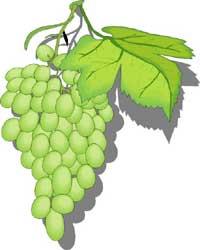Grape Grape Grape Grape Grape
Recent studies attribute, among other factors, cardiac health of the Mediterranean population to some of the substances contained in the grape.

The grape has 71 kcal per 100 grams and its main component is water (80.6%), as in many other fruits. It is followed by glucose and fructose sugars that easily pass into the blood (15-30%). The grapes in cold lands have less sugars than this, while the one cultivated in hot and dry medium is usually much sweeter. Of the 3,000 grape varieties that are produced in the world, the sweetest is the moscatel.
The 1% of the grape is a soluble fiber that helps avoid constipation. It has very few proteins and fats (0.5-0.6% each). Also, in small quantities, it contains mineral salts such as potassium, copper, iron and magnesium.
The sugars mentioned above, as well as the vitamins and phytochemical substances that will be exposed below, are the main ingredients of the grape. The most abundant vitamins are B 1 , B 2 , B 3 or niacin and B 6, being the richest fruit known in these vitamins. In addition, the amount of vitamins C and A of the grape is quite high.
The non-nutritious phytochemical substances present in the grape are:
- Flabonoids: prevent the oxidation of cholesterol and prevent the formation of thrombi in the arteries.
- Resveratrol: isoflavone of the surface of the grape, detected as antioxidant and anticancer.
- Anthocyanins: oxidizers in black and white grapes that prevent cardiovascular diseases.
In essence, it can be said that the grape protects blood health, in addition to laxative, diuretic, antitoxic, antianemic and antitumoral.
For all this, to those who with the excuse that the grape has a lot of sugar and that it thickens, we say that for its properties we consider it very necessary to consume this fresh fruit. Therefore, we want to encourage all readers to consume several grapes (15-20) each day or between four and five times a week at this time of year. Clean well and if you eat with skin, better.





